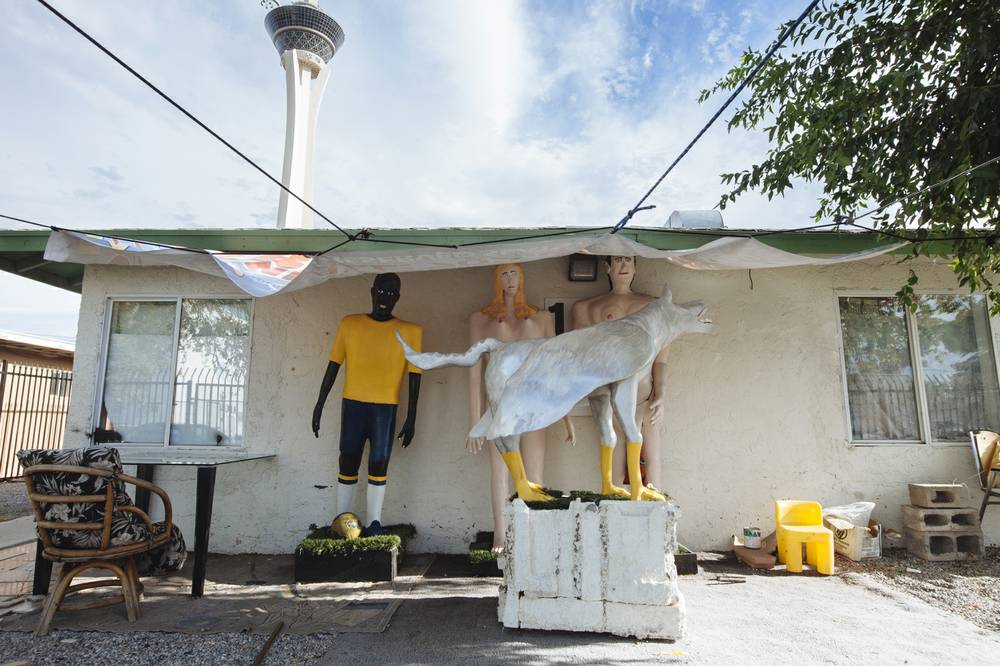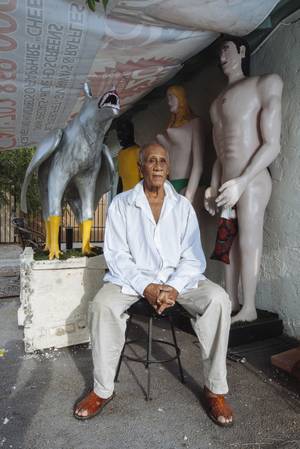The Giants sent to destroy Sodom and Gomorrah are riding in the back of artist Justin Favela’s pickup truck with retired Brazilian soccer player Pelé, all of them bound to keep from toppling.
This is precious cargo, a life’s work that until now had been living in the Downtown yard of 87-year-old artist Rafael Espino, displayed to the street for whoever might pass by.
The truck crawls down Main Street in rush-hour traffic with its hazards on, and pedestrians in the hot sun are rubbernecking, gawking, taken in by the painted Giants, towering and upright, naked except for a covering over their genitals. Pelé is jet black and secured by artist Jesse Carson Smigel, seated at the base. Turning onto Ogden, then onto Sixth, the truck stops at the alley behind Emergency Arts. Destination: Rhizome Gallery.
A week earlier, Favela and art liaison Emmanuel Ortega sat with Espino inside the Beat coffee shop on a drizzling Saturday, discussing Espino’s upcoming show and listening to his stories—22 years in a Cuban prison for fighting against Castro’s revolution, working as an engraver while incarcerated, so respected for his work that students from Academia de San Alejandro would come to learn from him.
This was a long mystery finally being solved. Favela and Smigel had driven past Espino’s house for more than a year, independent of the other, drawn to the artwork that had been carved and constructed using Styrofoam (a medium they share), joint compound and other found materials from his Downtown neighborhood.
“When I first saw it I automatically made a connection,” Favela says. “I knew that the person who made it was a person of color and made it for personal reasons. There was an honesty in the sculpture, and I wanted to know his motivations.”
Both reached out to find out who he is. Smigel wanted to offer him materials. Favela finally left a note on Espino’s door. Espino contacted him, and they met at his home. After an evening of talking, Favela wanted to to give him a show. Espino had no training, sourced no sculpting books. He created from his own inspiration, choosing subjects that came to him in a dream or popped into his mind and lingered. He’s made the hands of Christ for a church in Las Vegas; work for friends and for Santeria altars. A small white cat was made to keep company his own housecat, Kiki.
His style is his own. With the Giants, certain muscles are emphasized. Giant Man has protruding abdominals, a bulging chest and an elongated penis. The facial features are painted on, resulting in a bold, pop–art look. Pelé’s skin is coal black. He wears his soccer uniform and is mounted on a stand with fake grass. There’s a soccer ball at his feet, and Espino’s silver chupacabra has wings and yellow legs.
“They are incredibly powerful because of where they came from,” Ortega says, referring to Espino’s personal history as well as the materials, “the skin of the city,” some including the exterior of his house.
There are gray areas in Espino’s stories, moments when he’ll switch paths and discuss something else, but he’s comfortable telling his life experiences, how the watermelons grown at the prison were “red as blood and sweet like sugar;” how he’s healed people through spiritual powers; that he was born in Remedios, Cuba, and has been fighting governments since he was 14; and how his engraved objects and jewelry would end up all over the world, earning him the nickname “El internacional del Grabado.”
But his sculpture, he says, is for his own amusement. He’d work on his pieces in his yard/“open-air-studio” across from the Culinary Union from 6 a.m.-6 p.m., and some days for only one hour. When Smigel offered materials, Espino responded: “Materials, I have. What I don’t have is life. I’m done.” He then told Favela that his hands clench up at night.
Espino says he’s happy about the exhibit, and never thought something like this would happen.
The show, curated for Rhizome by Favela and Smigel, may have provided another burst of inspiration. This week, Espino was in his yard working on a new series.
Rafael Espino: El Internacional Through September 11; Thursday-Saturday, 1-5 p.m. (closing reception First Friday, September 4). Rhizome Gallery inside Emergency Arts, 702-907-7526.








